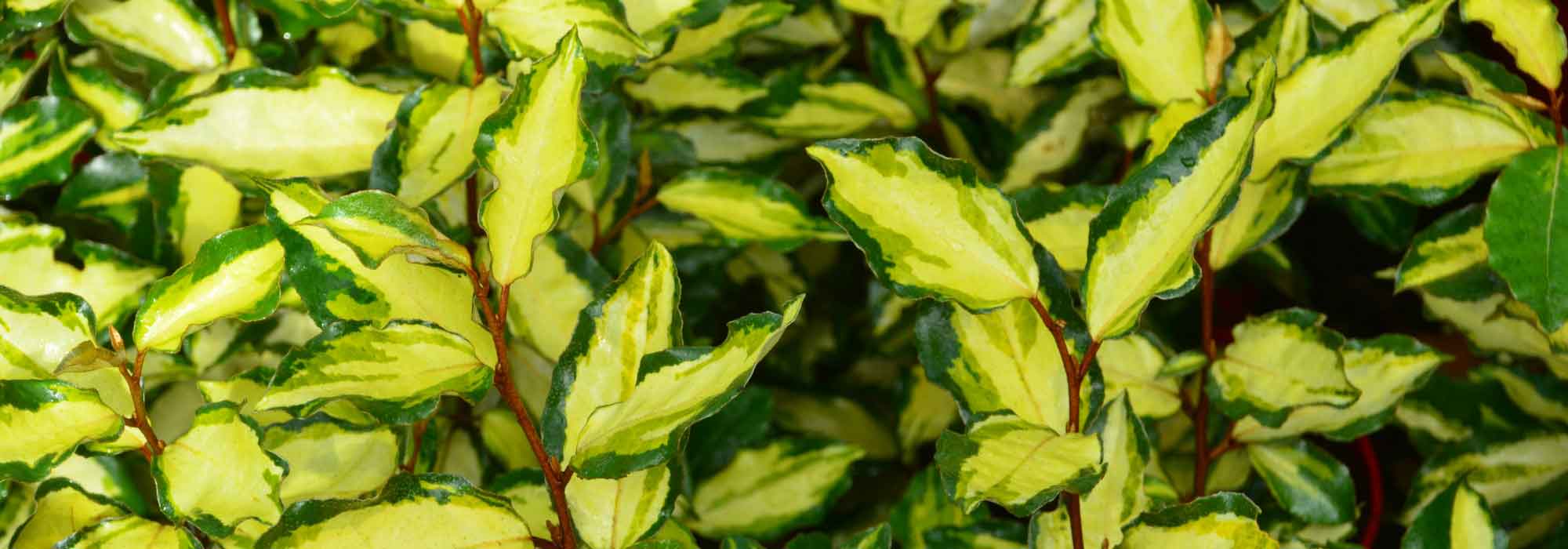
Eleagnus, Oleaster: planting, pruning and care tips
Contents
Eleagnus in a nutshell
- Eleagnus is a valuable bush for its beautiful evergreen foliage
- It is the preferred bush for creating hedges
- Its discreet yet highly fragrant flowering is followed by edible fruits
- It withstands everything: drought, wind, cold
- Heavy, light, rich or poor, Elaeagnus adapts to all soils
A word from our expert
Eleagnus, also known as oleaster, is a versatile bush, highly valued for creating trimmed hedges or windbreaks. It is prized for its bright green, silver, or variegated foliage, deciduous or evergreen depending on the species, and its discreet yet delightfully fragrant flowering followed by edible berries.
While the most well-known is Elaeagnus ebbingei or Ebbing’s oleaster, from which many cultivars with variegated green and yellow foliage (Elaeagnus ‘Limelight’, ‘Gilt Edge’, ‘elaeagnus x ebbingei ‘viveleg’) that retain their foliage in winter are derived, there are other varieties, particularly those with silver foliage, all equally interesting such as Elaeagnus angustifolia or “Bohemian olive” and Elaeagnus pungens Maculata.
Its versatile nature and resistance to pollution make it essential in all gardens, from coastal areas to urban gardens. Its extraordinary adaptability, rapid growth, and dense silhouette allow for numerous uses, from the most classic hedge to the most surprising topiary. Easy to cultivate and accommodating, Elaeagnus thrives in any well-drained soil, sandy, even dry and poor, without lime, in full sun or partial shade. It is among the most drought-resistant and wind-resistant bushes as well as tolerant of sea spray.
Discover our Elaeagnus or oleaster, hardy and resilient, they will bring a true source of light to your garden.
Description and Botany
Botanical data
- Latin name Elaeagnus
- Family Elaeagnaceae
- Common name Eleagnus, Chalef, Bohemian Olive
- Flowering May to November
- Height 2 to 10 m
- Exposure Sun, partial shade
- Soil type All, well-drained
- Hardiness -15°C to -20°C depending on varieties
Elaeagnus or Oleaster is a small tree or deciduous or evergreen bush, sometimes spiny, belonging to the family Elaeagnaceae. The genus includes 45 species that grow spontaneously along waterways as well as on grassy slopes and in dry meadows in Asia, southern Europe, and North America.
Among the most commonly cultivated are: Elaeagnus angustifolia, also known as “Bohemian Olive”, whose foliage resembles that of the olive tree; Elaeagnus commutata, a large and beautiful rare bush with deciduous grey-silver foliage; Elaeagnus umbellata and multiflora (goumi); Elaeagnus pungens; and the very common Elaeagnus ebbingei, a persistent hybrid between Elaeagnus macrophylla and pungens, along with its numerous cultivars.
 The bush takes about a year to establish itself, then shows average to very rapid growth. The stump of some species spreads by producing suckers, allowing it to thicken in just a few years. It forms a well-dense and ramified tuft, with a small trunk, reaching a maximum height of 1 to 10 m and nearly the same spread.
The bush takes about a year to establish itself, then shows average to very rapid growth. The stump of some species spreads by producing suckers, allowing it to thicken in just a few years. It forms a well-dense and ramified tuft, with a small trunk, reaching a maximum height of 1 to 10 m and nearly the same spread.
Elaeagnus has a variable ample habit, upright, rounded, or slightly trailing. Some, like Elaeagnus angustifolia, have a weeping habit with branches that arch slightly over time. Elaeagnus x reflexa, rarely cultivated, is notable for being a semi-climbing evergreen liana with spurs that allow it to cling to trees, making hedges impenetrable.
The bright and ever-moving foliage is the main attraction of Elaeagnus. The deciduous or evergreen vegetation is borne on branches and often slightly spiny or armed with strong sharp thorns that are decorative in winter. The bush is characterised by being covered in silver scales, giving it a shiny appearance.
From spring, it reveals its young shoots, branches, and petioles covered, especially on the underside, with characteristic silver or bronze-brown scales. This particularly decorative branchwork bears leathery, entire, alternate leaves, 2 to 10 cm long, elliptical to lanceolate, glossy, matte, or downy, often undulating at the edges. The lamina is dotted with small starry and translucent metallic-reflecting spots on the upper side, like stardust. On the underside, they are also covered with numerous brown or silver scales.
The leaves take, depending on the varieties, all shades of green, yellow, or grey, with intensity varying throughout the seasons. Olive green, very silver in spring, grey-green in summer, resembling those of a willow or an olive tree in Elaeagnus angustifolia; almond green to greyish, grey-silver in Elaeagnus commutata ‘Zempin’; or dark green with grey reflections, with lighter undersides, are remarkably variegated in some species, with dark yellow-streaked green in the centre for Elaeagnus pungens ‘Maculata’. All will shimmer beautifully in the slightest ray of sunshine.
Cultivars of Elaeagnus ebbingei such as ‘Limelight’, ‘Gilt Edge’, or ‘Eleador’ stand out for their brightness and display a lovely shiny variegated foliage of gold and green, all the more remarkable as it persists during the grey months of winter.
Provided you do not prune severely each year, this flowering bush, which blooms on the year’s shoots, will allow you to enjoy its discreet yet delightfully fragrant flowering. Depending on the species and varieties, it is spring-flowering in Elaeagnus angustifolia, summer-flowering in Elaeagnus commutata ‘Zempin’, or autumn-flowering in all Ebbing eleagnus. The flower buds are, like the rest of the plant, covered in scales with metallic reflections.
From May to November, small silver-white or yellowish-white flowers appear, discreetly grouped in bouquets of 3 or 4 in the axil of the leaves. These countless small tubular corollas, sometimes pendulous, end with 4 spreading petals, measuring 1 to 10 cm long.
Quite insignificant and hidden under the foliage, they nevertheless exude an exquisite fragrance, sometimes very powerful, reminiscent of jasmine, strawberry, or honey, detectable from several metres away. Highly melliferous and nectariferous, they are frequently visited by butterflies and other pollinators.
In autumn, they give way to small scaly fruits, also 1 to 3 cm long, resembling small yellow olives, brown-orange then red with silver bloom at maturity, highly appreciated by birds. All the berries of the different species of Elaeagnus are edible when harvested at maturity, although those of Elaeagnus multiflora, commonly known as goumi, are particularly tasty, tangy, and sweet. Best consumed cooked in jams or pastries, these berries are rather dry and floury but very rich in vitamins and minerals.
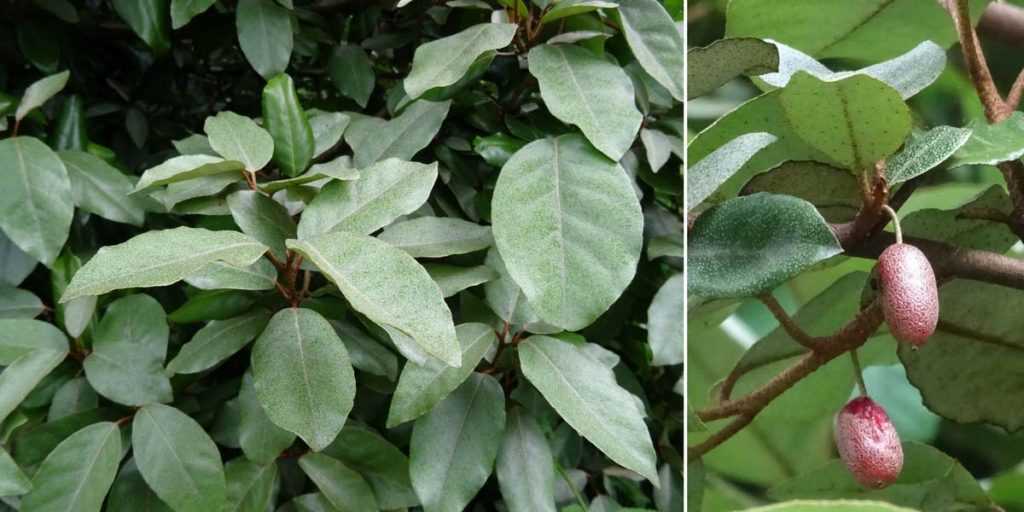
Elaeagnus is extraordinarily adaptable, low-maintenance, and very easy to cultivate. It withstands almost everything: drought, pollution, sea spray, and strong winds. It grows throughout France due to its good hardiness, around -15°C to -20°C. It enjoys sunny or semi-shaded exposures (in warm climates).
It accepts all types of well-drained soil. It even tolerates poor and ungrateful soils. However, it is sensitive to heavy, calcareous soils and stagnant moisture, especially in winter.
Elaeagnus has its place in all gardens, by the sea or in dry gardens. Its moderate size and dense silhouette allow for numerous uses: in a mixed, trimmed, or flowering hedge, as a fruit hedge or windbreak, it can also be grown in isolation and in borders. And even trimmed into topiary!
Elaeagnus means “sacred olive” in ancient Greek. The vernacular term “chalef” means “willow” in Arabic, probably because the leaves of some Elaeagnus resemble those of willows, with which they were thought to be related.
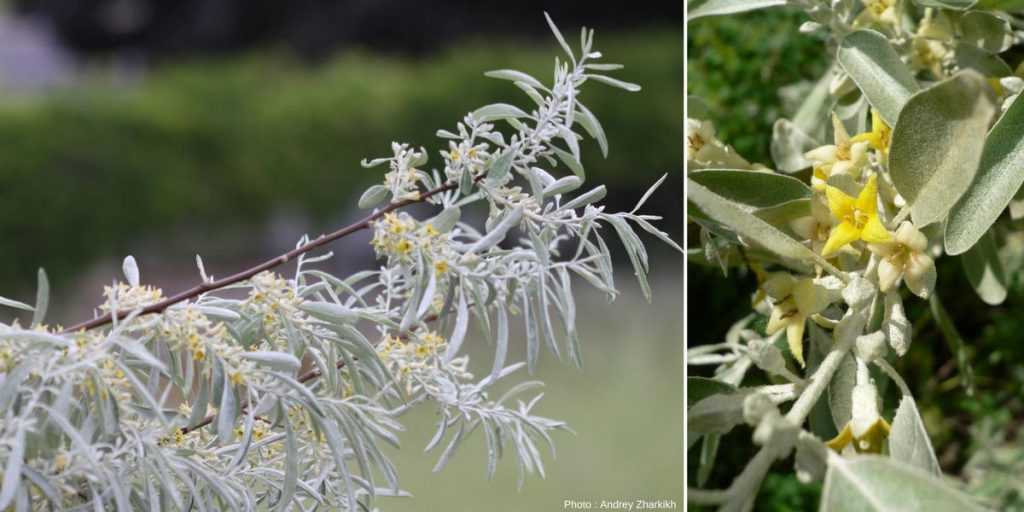
Elaeagnus angustifolia – Bohemian Olive – Flowering branch and detail of the flower
Species and varieties
There are about fifty species of Elaeagnus worldwide, but only a few are available for sale in France, which can be divided into evergreen Elaeagnus such as Elaeagnus ebbingei, which comes in around ten cultivars including the famous ‘Limelight’, and deciduous ones like Elaeagnus angustifolia.
Elaeagnus also vary in size, ranging from hedging or border bushes that do not exceed 3 m in height to small trees (up to 10 m tall at most).
You can choose varieties with variegated foliage (‘Gilt Edge’, ‘Limelight’, Maculata), perfect for brightening up dull areas of the garden, especially as they retain their foliage in winter, or a bush adorned with silver foliage (angustifolia or commutata) that plays beautifully with the wind and light.
All are hardy, highly adaptable, and fast-growing, used in hedges, particularly Elaeagnus ebbingei and its hybrids, which are very popular, but also by the seaside, as specimens, in topiary, etc.
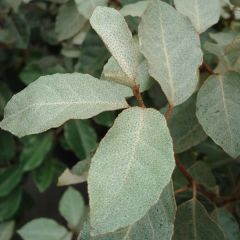
Elaeagnus ebbingei - Oleaster Silverberry
- Flowering time October to December
- Height at maturity 3 m
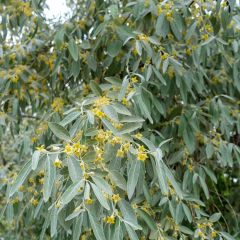
Elaeagnus angustifolia - Russian Olive
- Flowering time June, July
- Height at maturity 5 m
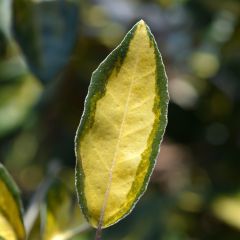
Elaeagnus ebbingei Limelight - Oleaster
- Flowering time October to December
- Height at maturity 3 m
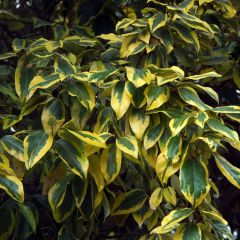
Elaeagnus ebbingei Gilt Edge - Oleaster
- Flowering time October to December
- Height at maturity 2 m
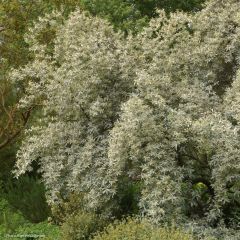
Elaeagnus commutata Zempin - Silverberry
- Flowering time June, July
- Height at maturity 3 m
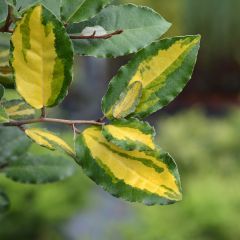
Elaeagnus ebbingei Eleador - Oleaster
- Flowering time October to December
- Height at maturity 1,75 m

Elaeagnus pungens Variegata
- Height at maturity 3,50 m
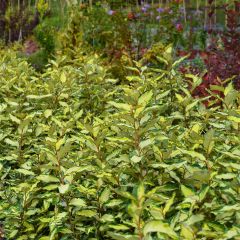
Elaeagnus ebbingei Maryline - Oleaster
- Flowering time October to December
- Height at maturity 2 m
Discover other Elaeagnus - Oleaster
View all →Available in 3 sizes
Available in 2 sizes
Available in 4 sizes
Available in 1 sizes
Available in 1 sizes
Available in 1 sizes
Available in 1 sizes
Available in 1 sizes
Available in 2 sizes
Available in 1 sizes
Planting
Where to Plant Oleaster?
The Elaeagnus can be found throughout France, with deciduous varieties exhibiting good cold resistance capable of enduring frosts down to -20°C. Some evergreen species, such as Elaeagnus ebbingei, offer less hardiness. While they can withstand short frosts of around -12°C in perfectly drained soil, they are better suited to milder climates. Evergreen Elaeagnus tolerate summer drought very well once established, while deciduous varieties are more resistant to cold but slightly less so to drought.
Its suckering root system allows it to stabilise soils and withstand strong winds. It tolerates salt spray well, and is frequently found in coastal gardens. This is a compact bush that is well-suited to small gardens or urban gardens, especially as it is quite resistant to pollution.
The Elaeagnus can be planted in full sun or partial shade, sheltered from direct sunlight in hot climates where its foliage (especially for variegated varieties) may be scorched by excessive heat. Its drought resistance allows it to thrive in poor soils, even stony and barren, especially as it can enrich the surrounding soil due to the presence of bacteria in its roots.
Indifferent to soil type, it grows well in any good, well-drained garden soil: it only fears heavy, compacted, and waterlogged soils, especially in winter, as well as chalky soils. A constantly wet soil can almost certainly kill it! The exception is Elaeagnus commutata Zempin, a horticultural selection that tolerates everything: chalk, sandy soils, whether dry or wet!
Fast-growing, Elaeagnus is perfect for quickly forming a hedge. Decorative all year round, the evergreen varieties are an excellent choice for a free or trimmed hedge composed of one or more species. With its sharp thorns, it also makes an excellent defensive hedge.
Cultivars with yellow and light green variegated foliage, such as ‘Gilt Edge’ or ‘Limelight’, are better suited for isolated planting in the heart of a flowerbed. The modest size of some varieties allows for pot cultivation on a terrace or balcony to fully enjoy their remarkable fragrance.
When to Plant Oleaster?
Plant Elaeagnus at any time in spring in March or in autumn in September, which promotes rooting before winter. However, it can also be planted from February to May, avoiding periods of frost or extreme heat.
How to Plant Oleaster?
1) In the Ground
For hedges: space the plants 0.80 to 1 m apart and plant in light, well-draining soil without excessive lime.
- Dig a hole or trench three times wider than the root ball and 40 to 50 cm deep
- Mix the extracted soil with potting soil in equal parts
- Make a good bed of gravel or clay balls to ensure perfect drainage
- Place the shrub in the centre of the hole, with the collar level with the soil
- Bring back the extracted soil to encase the roots and fill the hole
- Keep the shrub upright and compact with your foot
- Water thoroughly at planting and weekly during the first year to encourage establishment
2) Pot Cultivation
Pot cultivation is possible in a container at least 30 cm high and 40 cm in diameter. Choose evergreen varieties and very compact forms such as Elaeagnus ebbingei Compacta, and Elaeagnus ebbingei ‘Maryline Abrela’. Plant it in a rich, very well-draining soil mix, as it does not tolerate stagnant moisture. Make a good bed of clay balls. Water regularly. Repot every 3 years.
→ Learn more in our advice sheet: Growing an Eleagnus in a Pot
Care and pruning
Once well established, Elaeagnus requires very little care; it is a bush that is resistant to both cold and heat. It will harden over the years.
From March to October, during the period of lush vegetative growth, water more but sparingly: it does not tolerate standing water at its base. Once well established, it will manage without watering, even in hot climates. In the first few years, apply a mulch of fallen leaves or ferns to protect the base from severe frosts.
On all variegated Elaeagnus, any green shoot must be removed. Cut back green shoots and green suckers (a phenomenon sometimes observed in variegated varieties), otherwise they will eventually dominate.
Regular pruning is recommended. Elaeagnus grows very quickly and while it has the advantage of forming hedges rapidly, it needs to be pruned often, at least twice a year to maintain a bushy habit, an attractive appearance, and especially the desired height. It can be easily shaped according to the form and height you wish to give it, whether as a trimmed hedge or in topiary. When not pruned, Elaeagnus ebbingei tends to become sarmentous and will climb if it encounters a support.
Elaeagnus is not afraid of pruning and can even be severely cut back if necessary, but you will then miss out on its fragrant flowering. Intervene at the end of winter to avoid compromising the flowering.
- In the first few years, carry out formative pruning: cut back to one third of the height to encourage the appearance of new stems and a dense development.
- To create a well-dense separating hedge, preferably prune twice a year: once at the end of winter and a second time in mid-summer.
- In a free hedge or isolated planting, it will only require balancing pruning to maintain a harmonious silhouette and keep a compact habit, generous flowering and fruiting, and dense foliage. In February-March, when the plant is still dormant, and to enjoy the flowers and fruits, cut back damaged or dead branches and remove rebellious, eccentric, or tangled stems.
Diseases and potential pests
Installed in the right growing conditions, the eleagnus is a hardy bush resistant to pests. It has few enemies. In waterlogged and poorly drained soil, it will be threatened by diseases caused by devastating fungi such as coral disease, identifiable by its small orange pustules (how to prevent it?), which lead to wilting, or even total defoliation of the bush.
In overly calcareous or excessively moist soil, it may suffer from chlorosis, which manifests as a gradual yellowing of the leaves and ultimately leads to the wilting of the bush.
A well-drained soil regularly amended with an addition of compost or turf will help prevent these attacks. Some branches may suddenly dry out completely, indicating a lack of water. Remove the dry branches and water without excess.
Psyllids, a type of sap-sucking aphid, may eventually infest the bush and weaken it: yellowing of the leaves, glued and deformed young shoots, and the presence of waxy filaments are signs indicating their presence. Perform diluted black soap sprays at 5%, as with aphids. They can also be eradicated by natural predators such as ladybirds or hoverflies.
→ Learn more about the diseases and pests of Eleagnus in our advice sheet.
Multiplication
Elaeagnus can be propagated by sowing, by separating suckers and by cuttings. The simplest method is to take semi-woody cuttings in summer. Sowing is quite tedious and lengthy, as fruiting occurs only 4 to 5 years after sowing.
Semi-woody cutting
- Carry out between mid-July and September
- Using pruning shears, cut branches just below an eye, 10 cm long from this year’s shoots, with the base being semi-hardened, that is, harder and woody
- Remove the leaves from the bottom of the stem
- Plant the cuttings in trays, spacing them 10 cm apart, in a mixture of turf, river sand, and potting soil
- Place under a frame or bell or plastic film
- Keep the substrate moist until rooting
- Once well-rooted, gently separate the cuttings and repot them individually in pots filled with potting soil
- Keep protected from frost in winter
- Cut back the shoots by a third of their height to encourage branching
- Repot if necessary and only transplant into the ground two years later in spring
By separating suckers
You can easily propagate Elaeagnus by dividing the offsets. In October, using a spade, separate the rooted suckers that you will replant immediately, taking care to water well.
Associating
With its bright foliage that plays beautifully with the wind and light, Elaeagnus or Chalef awakens the somewhat dull areas of the garden. Its great adaptability makes it an excellent plant for hedges or borders. Its bushy habit and the brilliance of its variegated leaves make it very decorative.
It is valuable in a seaside garden or a dry garden. Highly resistant to pollution, it is also perfect for urban gardens. It pairs well in hedges with all types of bushes such as cotoneasters or Cistus laurifolius and in the background of borders for the taller varieties, combined with variegated and evergreen plants, such as dogwoods or aucubas.
In a mixed hedge, it will stand out alongside other beautiful shrubs such as Abelia x grandiflora, Arbutus unedo, Amelanchiers, Buddleia alternifolia Argentea. To complement the bright hue of its foliage, pair it in a border with other colourful plants like lavenders, creeping ocean blue, shrubby lavateras.
The variegated cultivars of E. x ebbingei, with evergreen leaves edged or spotted with bright yellow or green contrast with blue cultivars of ocean blue or will serve as support for climbing plants like Lonicera nitida ‘Lemon Beauty’.
In a free-flowing and flowering hedge, they will be remarkable alongside a Buddleia davidii ‘Masquerade’, in a defensive hedge with a Pyracantha ‘Soleil d’or’.
For a beautiful effect, mix different species of Elaeagnus in a hedge by freely combining evergreens and deciduous ones, and choose to accompany them with shrubs that flower at different times like keria japonica or Japanese corète, laurustinus, weigelias, cotinus, deutzias, mock oranges or even forsythias.
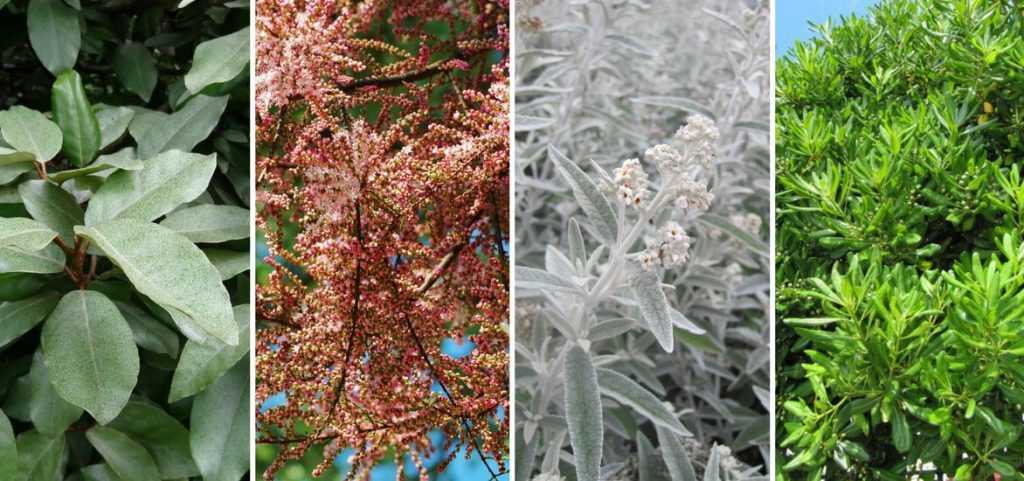
An example of a hedge association for the seaside: Elaeagnus ebbingei, Tamarix, Buddleia ‘Silver Anniversary’ and Pittosporum taubira
While all Elaeagnus varieties mix very well together, they pair perfectly with Escallonia, Olearia, Tamaris and Griselinia, with Euonymus Alatus – Winged Spindle, Amelanchier Spicata. In a windbreak hedge, accompany it with photinia.
While deciduous Elaeagnus are stunning in spring, after flowering, they take on a rather unremarkable appearance, so be sure to surround them well. Buddleia ‘Silver Anniversary’ will be the ideal companion to take over from Elaeagnus commutata Zempin in a silver-grey harmony, enhanced by old roses, blue-flowering shrubs or even yellow-flowering potentillas.
Useful resources
- Discover our Elaeagnus or oleaster at all prices, including some rare new varieties!
- Learn more about the pruning of Elaeagnus
- How to choose an Elaeagnus wisely
- Discover our ideas to combine Elaeagnus
- Our advice sheet: Variegated Elaeagnus: the most beautiful varieties
- Discover our advice sheet: plants resistant to sea spray
Frequently asked questions
-
Why is my eleagnus turning yellow?
The oleander is a plant known for its resilience even in difficult situations. There are many possible causes. However, if the leaves are yellowing and gradually falling, it is likely suffering from iron chlorosis caused by an excess of lime, moisture, or a mineral deficiency in the soil. Treat with chelated iron and apply compost by scratching it into the soil at the base of the bush. It may also fall victim to a psyllid infestation, these harmful insects responsible for the yellowing and decline of the leaves. The use of beneficial insects like ladybirds and sprays of soapy water should help to eliminate them.
-
Are the leaves of my eleagnus drying out, is it serious?
In cases of extreme heat and prolonged drought, especially in young specimens, some branches may suddenly dry out completely, indicating a likely lack of water. Remove the dry branches and water regularly, but avoid excess as this bush is sensitive to stagnant moisture at its base. It should recover!
-
Why are green shoots appearing on my variegated eleagnus?
This is a phenomenon quite characteristic of variegated foliage plants that are prone to the greening of their young shoots. This is known as a "reversion to type." The variegated stems that revert to green should be removed as soon as they appear, or you risk your variegated bush turning completely green! This reversion phenomenon occurs when the plant is over-fertilised with nitrogen or placed in a location that is either too sunny or, conversely, too shaded.
- Subscribe!
- Contents































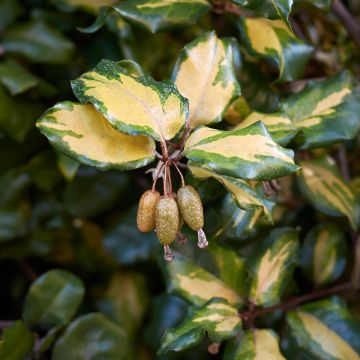


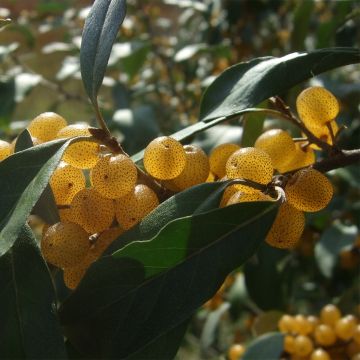
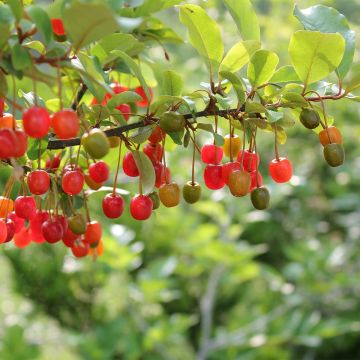

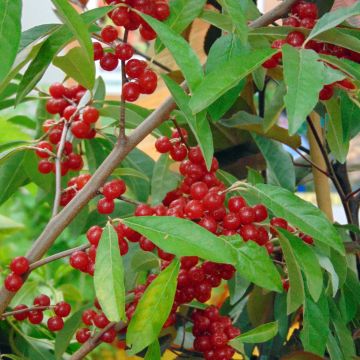
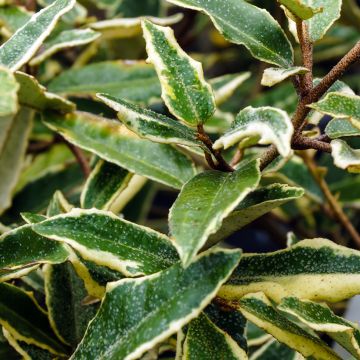


Comments